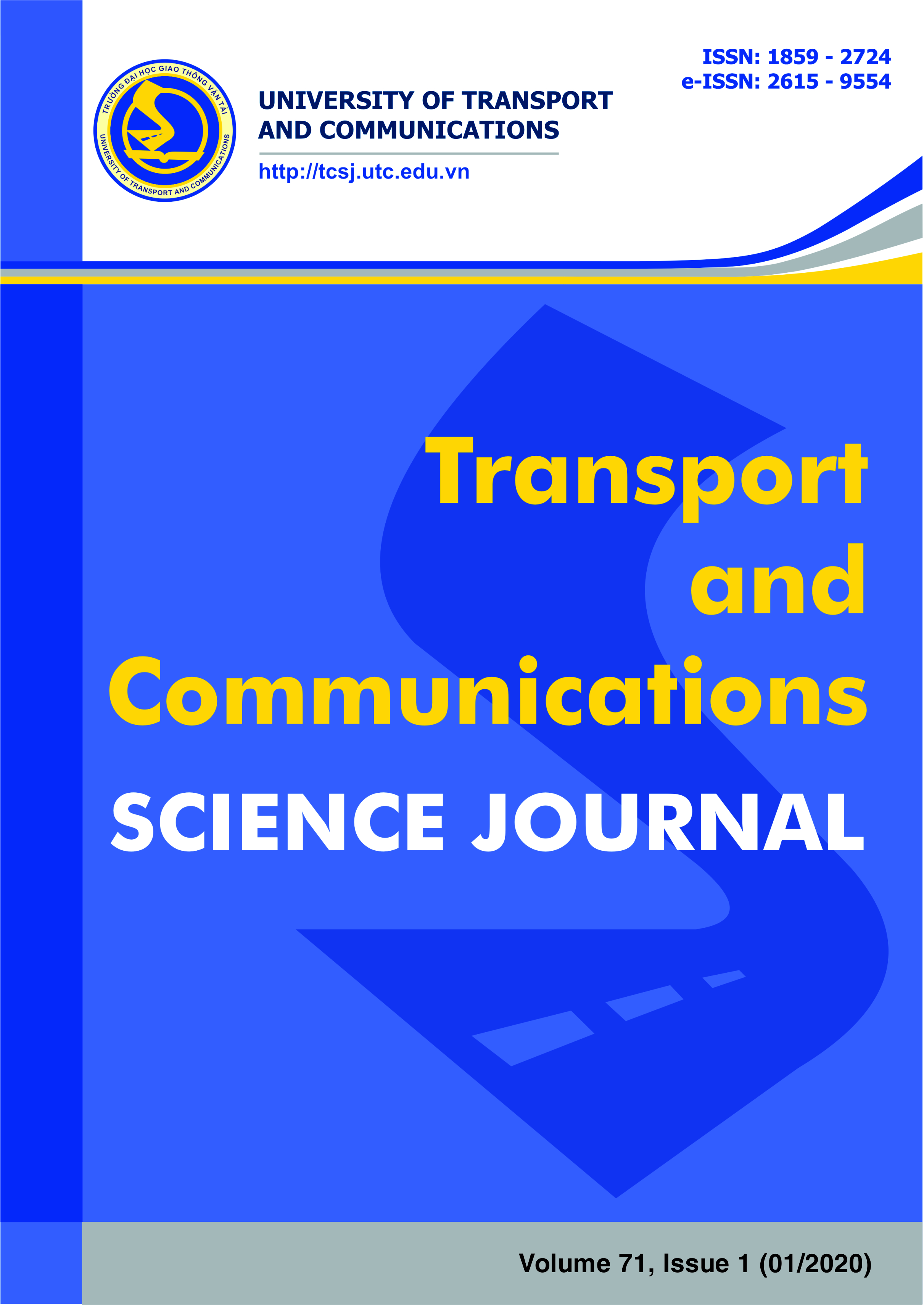Experimental study on flexural and shear behaviour of sandwich panels using glass textile reinforced concrete and autoclaved aerated concrete
Email:
bttmai@utc.edu.vn
Từ khóa:
Textile reinforced concrete, TRC, AAC, sandwich, flexure, shear
Tóm tắt
Textile-reinforced concrete (TRC) is a new composite material made of high-strength textiles embedded within fine grained concrete (FGC). The application of TRC leads to the design of thin and slender structures or for repairing and strengthening of existing structural members. Autoclaved aerated concrete (AAC) is an ultra-lightweight concrete, which can be combined with high strength TRC to form some kinds of precast curtain panels in construction. The concept of the TRC-AAC panel is based on the theory of sandwich construction with strong and stiff skins, like TRC layers, bonded to a lightweight AAC core. The resulting hybrid TRC-AAC panel can be used as structural or non-structural member for the housing construction. In this paper, the flexural and shear performance of hybrid TRC-AAC sandwich panels is presented by means of experimental results. The sandwich panels use three layers of different materials: TRC for the tensile layer, AAC for the core material and FGC for the compressive layer. Three different types of glass textile were used as reinforcements in the TRC layers.Tài liệu tham khảo
[1] W. Brameshuber, Textile Reinforced Concrete. State-of-the Art, Report of RILEM Technical Comittee 201-TRC, 1st ed. Bagneux, vol. 36: RILEM Publications S.A.R.L., 2006.
[2] H. C. Nguyen, D.Q. Ngo, Flexural behavior of reinforced concrete beam strengthened by textile reinforced concrete: Experimental and numerical study, The Indian Concrete Journal, 92 (2018) 28-43.
[3] H. C. Nguyen, D.Q. Ngo, Numerical Analysis of Reinforced Concrete Beams Strengthened with Textile Reinforced Concrete, Proceedings of the International Conference on Engineering Mechanics and Automation-ICEMA3, Hanoi, Vietnam, October 15, 2014.
[4] J. Hegger, M. Horstmann, A. Scholzen, Sandwich panels with thin-walled textile-reinforced concrete facings, In American Concrete Institute (ACI) Special Publication, 2008. DOI: 10.14359/20153
[5] H.N. Schneider et al., Modulare Bausystemeaus Textilbeton-sandwichelementen, 4th Colloquium on Textile Reinforced Structures, (2009) 565–576.
[6] V. A. Nguyen, A study on Textile Reinforced - and Expanded Polystyrene Concrete sandwich beams, PhD Dissertation, Technische Universität Dresden, 2016.
[7] V.H. Vu, D. Q. Ngo, T .T .T. Nguyen, H. C. Nguyen, Experimental analysis of sandwich panels using textile reinforced concrete faces and light weight concrete core, Science Journal of Transportation, Especial Issue No. 08, 2018.
[8] J. Radosław, D. Łukasz, Study of autoclaved aerated concrete masonry walls with horizontal reinforcement under compression and shear, Procedia Engineering, 161(2016) 918-924. https://doi.org/10.1016/j.proeng.2016.08.758
[9] M. Mousa, N. Uddin, Experimental and analytical study of carbon fiber-reinforced polymer (FRP)/autoclaved aerated concrete (AAC) sandwich panels, Journal of Engineering Structures, 31 (2009) 2337-2344. https://doi.org/10.1016/j.engstruct.2009.05.009
[10] N. Uddin, M.A. Mousa, U. Vaidya, F.H. Fouad, Book chapter: Design of hybrid fiber-reinforced polymer (FRP)/autoclave aerated concrete (AAC) panels for structural applications, In Woodhead Publishing Series in Civil and Structural Engineering, Developments in Fiber-Reinforced Polymer (FRP) Composites for Civil Engineering, Woodhead Publishing, 2013, 226-248.
[2] H. C. Nguyen, D.Q. Ngo, Flexural behavior of reinforced concrete beam strengthened by textile reinforced concrete: Experimental and numerical study, The Indian Concrete Journal, 92 (2018) 28-43.
[3] H. C. Nguyen, D.Q. Ngo, Numerical Analysis of Reinforced Concrete Beams Strengthened with Textile Reinforced Concrete, Proceedings of the International Conference on Engineering Mechanics and Automation-ICEMA3, Hanoi, Vietnam, October 15, 2014.
[4] J. Hegger, M. Horstmann, A. Scholzen, Sandwich panels with thin-walled textile-reinforced concrete facings, In American Concrete Institute (ACI) Special Publication, 2008. DOI: 10.14359/20153
[5] H.N. Schneider et al., Modulare Bausystemeaus Textilbeton-sandwichelementen, 4th Colloquium on Textile Reinforced Structures, (2009) 565–576.
[6] V. A. Nguyen, A study on Textile Reinforced - and Expanded Polystyrene Concrete sandwich beams, PhD Dissertation, Technische Universität Dresden, 2016.
[7] V.H. Vu, D. Q. Ngo, T .T .T. Nguyen, H. C. Nguyen, Experimental analysis of sandwich panels using textile reinforced concrete faces and light weight concrete core, Science Journal of Transportation, Especial Issue No. 08, 2018.
[8] J. Radosław, D. Łukasz, Study of autoclaved aerated concrete masonry walls with horizontal reinforcement under compression and shear, Procedia Engineering, 161(2016) 918-924. https://doi.org/10.1016/j.proeng.2016.08.758
[9] M. Mousa, N. Uddin, Experimental and analytical study of carbon fiber-reinforced polymer (FRP)/autoclaved aerated concrete (AAC) sandwich panels, Journal of Engineering Structures, 31 (2009) 2337-2344. https://doi.org/10.1016/j.engstruct.2009.05.009
[10] N. Uddin, M.A. Mousa, U. Vaidya, F.H. Fouad, Book chapter: Design of hybrid fiber-reinforced polymer (FRP)/autoclave aerated concrete (AAC) panels for structural applications, In Woodhead Publishing Series in Civil and Structural Engineering, Developments in Fiber-Reinforced Polymer (FRP) Composites for Civil Engineering, Woodhead Publishing, 2013, 226-248.
Tải xuống
Chưa có dữ liệu thống kê

Nhận bài
13/11/2019
Nhận bài sửa
12/01/2020
Chấp nhận đăng
13/01/2020
Xuất bản
31/01/2020
Chuyên mục
Công trình khoa học
Kiểu trích dẫn
Bui Thi Thanh, M., Nguyen Huy, C., Ngo Dang, Q., & Dinh Huu, T. (1580403600). Experimental study on flexural and shear behaviour of sandwich panels using glass textile reinforced concrete and autoclaved aerated concrete . Tạp Chí Khoa Học Giao Thông Vận Tải, 71(1), 18-26. https://doi.org/10.25073/tcsj.71.1.3
Số lần xem tóm tắt
276
Số lần xem bài báo
410









